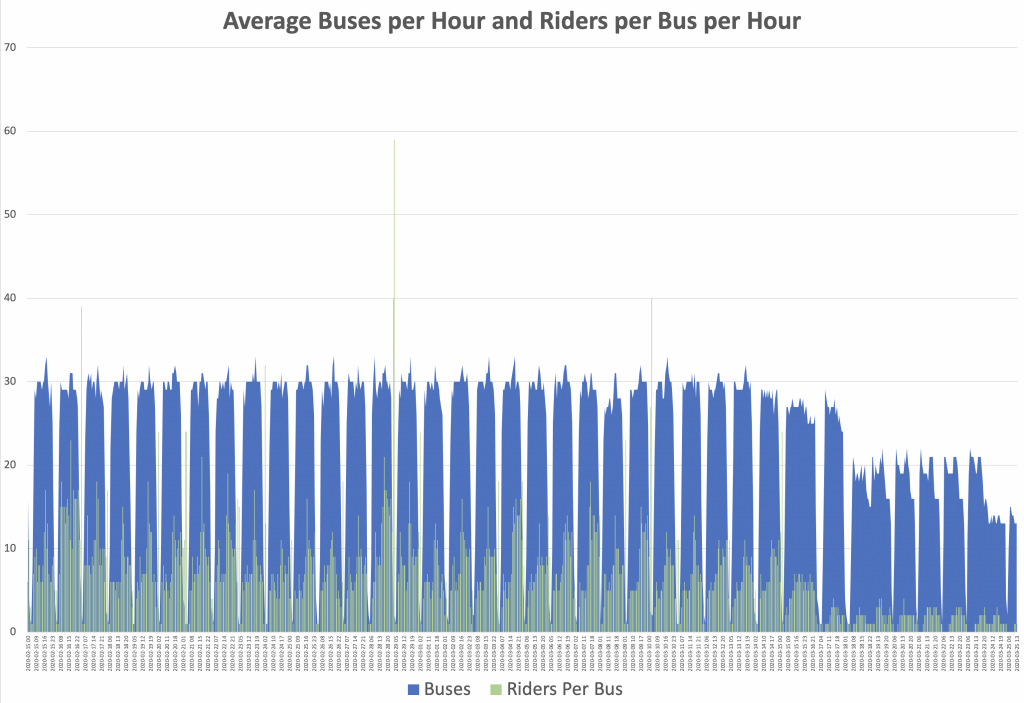Visualizing the coronavirus impact on Park City buses
I’m a fan of Park City’s bus system. When I am going skiing or coming downtown, I tend to take mass-transit. While sometimes the bus is full (4th of July, Miner’s Day, early ski mornings), often-times I am riding with few others.
Given the recent pandemic, I wondered what the impact was on Park City buses.
It turns out the impact is large.
During the winter, Park City Transit has about 30 buses on the road at any given time. During the period of February 15 until March 15, 2020, there was an average of 8.7 riders per bus, according to publicly available Park City Transit data. That’s fairly normal.
Since then there is an average of 2.2 riders per bus. If you look at this week’s data there is an average of 1.1 riders per bus. Ridership is plummeting. Due to this, the Park City Transit system has implemented spring schedules and then further cut back hours.

In the graph above, the blue area is the number of buses running each hour. The green line is the average number of riders per bus each hour. The Y-axis is the number and the X-axis is the date from 2/15 until 3/25. Click here for a larger graph. You can see that about 30 buses were on the road until March 18, when the system abruptly went to a spring schedule. You can also see the drop-off in riders per bus on March 17, once the resorts (and restaurants) closed.
It’s frankly not surprising. Park City Mayor Andy Beerman noted in December that the bus system was “mostly for tourists.” There aren’t many of those folks left.
What’s left are likely the people whose jobs remain and need the bus. It’s not many, but it is important to those that depend on it. Also, keep in mind from an environmental standpoint that the rule of thumb is that you need about 9 people on a diesel bus to make it environmentally break-even.
So, it’s likely some hard decisions need to be made. If the tourists are going to be away for the next 6 months, do we need another approach for those who need to get to work? Can we use the Kimball Junction Circulator? Can we use the special needs buses for point to point travel? Are there other options?
If that’s too much to contemplate during these trying times, I would suggest you take the bus if you can. There will likely be only two people on the bus — you and the driver. It shouldn’t be hard to get six feet apart.

Comments
3 Comments
I rode the bus today and looking at the new app it shows the number of riders. When I boarded the bus the number of “active riders” on the bus changed from 12 to 16. However, there were only 4 of us on the bus. Park Rag should investigate this!!
Thanks, Chad.I’ve always wanted to figure out exactly what the app numbers mean. I track them at the minute interval through a public API. So, it gives me a bird’s eye view. I generally trust them as they seem “about” the number of folks on the bus. When it’s not, I have always suspected that the app is a little delayed. That said, I’ll poke into it a bit and let everyone know what I find.
Overall, thanks for riding the bus. Right now it is incredibly difficult due to the Covid-19 implications. However, long-term it is the only solution if we want to beat traffic.
With an average of 8.7 riders per bus is it time to consider moving to smaller buses? Or how about rethinking the fixed-route public transit service altogether in favor of a mixed transportation model integrating a suite of partners and services that likely would offer enhanced services at a lower cost.
Leave a Comment